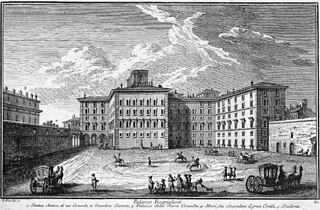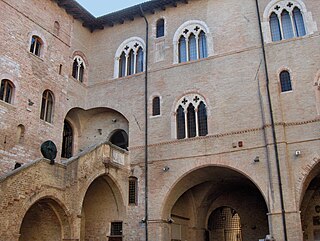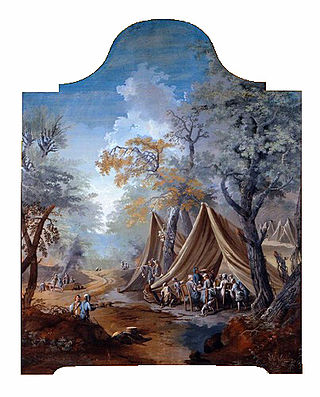
Giovanni Battista Tiepolo, also known as GiambattistaTiepolo, was an Italian painter and printmaker from the Republic of Venice who painted in the Rococo style, considered an important member of the 18th-century Venetian school. He was prolific, and worked not only in Italy, but also in Germany and Spain.

The Apostolic Palace is the official residence of the Pope, the head of the Catholic Church, located in Vatican City. It is also known as the Papal Palace, the Palace of the Vatican and the Vatican Palace. The Vatican itself refers to the building as the Palace of Sixtus V, in honor of Pope Sixtus V, who built most of the present form of the palace.

Pietro da Cortona was an Italian Baroque painter and architect. Along with his contemporaries and rivals Gian Lorenzo Bernini and Francesco Borromini, he was one of the key figures in the emergence of Roman Baroque architecture. He was also an important designer of interior decorations.

The Palazzo Vecchio is the town hall of Florence, Italy. It overlooks the Piazza della Signoria, which holds a copy of Michelangelo's David statue, and the gallery of statues in the adjacent Loggia dei Lanzi.

Odoardo Farnese was an Italian nobleman, the second son of Alessandro Farnese, Duke of Parma and Maria of Portugal, known for his patronage of the arts. He became a Cardinal of the Roman Catholic Church in 1591, and briefly acted as regent of the Duchy of Parma and Piacenza for his nephew Odoardo from 1622 to 1626.

Palazzo Pamphilj, also spelled Palazzo Pamphili, is a palace facing onto the Piazza Navona in Rome, Italy. It was built between 1644 and 1650.

Giovanni Lanfranco was an Italian painter of the Baroque period.

The Basilica of San Petronio is a minor basilica and church of the Archdiocese of Bologna located in Bologna, Emilia Romagna, northern Italy. It dominates Piazza Maggiore. The basilica is dedicated to the patron saint of the city, Saint Petronius, who was the bishop of Bologna in the fifth century. Construction began in 1390 and its main facade has remained unfinished since. The building was transferred from the city to the diocese in 1929; the basilica was finally consecrated in 1954. It has been the seat of the relics of Bologna's patron saint only since 2000; until then they were preserved in the Santo Stefano church of Bologna.

Girolamo Romani, known as Romanino, was an Italian High Renaissance painter active in the Veneto and Lombardy, near Brescia. His long career brought forth several different styles.

The Palazzo Pallavicini-Rospigliosi is a palace in Rome, Italy. It was built by the Borghese family on the Quirinal Hill; its footprint occupies the site where the ruins of the baths of Constantine stood, whose remains still are part of the basement of the main building, the Casino dell'Aurora. Its first inhabitant was the famed art collector Cardinal Scipione Borghese, the nephew of Pope Paul V, who wanted to be housed near the large papal Palazzo Quirinale. The palace and garden of the Pallavicini-Rospigliosi were the product of the accumulated sites and were designed by Giovanni Vasanzio and Carlo Maderno in 1611–16. Scipione owned this site for less than a decade, 1610–16, and commissioned the construction and decoration of the casino and pergolata, facing the garden of Montecavallo. The Roman palace of this name should not be mistaken for the panoramic Villa Pallavicino on the shores of Lake Como in Lombardy. The Palace has also been the scene of important cultural and religious events. On June 6, 1977 Princess Elvina Pallavicini invited in Palazzo Pallavicini Rospigliosi the archbishop monsignor Marcel Lefebvre for a conference on the Second Vatican Council and for the celebration of a Traditiona Mass, under the careful direction of the marquis Roberto Malvezzi, and Frigate Captain marquis Luigi Coda Nunziante di San Ferdinando. Many members of Alleanza Cattolica, the baron Roberto de Mattei, the pharmacologist Giulio Soldani, the sociologist Massimo Introvigne, the psychiatrist Mario Di Fiorino and Attilio Tamburrini and his brother Renato Tamburrini took part to the event.

The Palazzo Ducale di Mantova is a group of buildings in Mantua, Lombardy, northern Italy, built between the 14th and the 17th century mainly by the noble family of Gonzaga as their royal residence in the capital of their Duchy. The buildings are connected by corridors and galleries and are enriched by inner courts and wide gardens. The complex includes some 500 rooms and occupies an area of c. 34,000 m2, which make it the sixth largest palace in Europe after the palaces of the Vatican, the Louvre Palace, the Palace of Versailles, the Royal Palace of Caserta and the Castle of Fontainebleau. It has more than 500 rooms and contains seven gardens and eight courtyards. Although most famous for Mantegna's frescos in the Camera degli Sposi, they have many other very significant architectural and painted elements.

The Royal Palace of El Pardo is one of the official residences of the Spanish royal family and one of the oldest, being used by the Spanish monarchs since Henry III of Castile in the 15th century. It is administered by the Patrimonio Nacional agency and it currently serves as a state guest house.

The Palazzo della Consulta is a late Baroque palace in central Rome, Italy; since 1955, it houses the Constitutional Court of the Italian Republic. It sits across the Piazza del Quirinale from the official residence of the President of the Italian Republic, the Quirinal Palace.

Palazzo Carignano is a historical building in the centre of Turin, Italy, which houses the Museum of the Risorgimento. It was a private residence of the Princes of Carignano, after whom it is named. Its rounded façade is different from other façades of the same structure. It is located on the Via Accademia delle Scienze.

Johann Baptist Zimmermann was a German painter and a prime stucco plasterer during the Baroque.

Angelo Michele Colonna was an Italian painter of the Baroque period, active in Bologna, northern and central Italy and Spain. He is sometimes referred to as Michelangelo Colonna.

The Trinci Palace is a patrician residence in the center of Foligno, central Italy. It houses an archaeological museum, the city's picture gallery, a multimedia museum of Tournaments and Jousts and the Civic Museum.

The Palazzo Biscari is a monumental private palace located on Via Museo Biscari in Catania, Sicily, southern Italy. The highly decorative interiors are open for guided tours, and used for social and cultural events.

Moses Leaving for Egypt is a fresco by the Italian Renaissance painter Pietro Perugino and his workshop, executed around 1482 and located in the Sistine Chapel, Rome. It depicts a journey by the prophet Moses.

Carlo Lodi was an Italian painter of the late-Baroque period in Bologna, mainly painting landscapes.





















